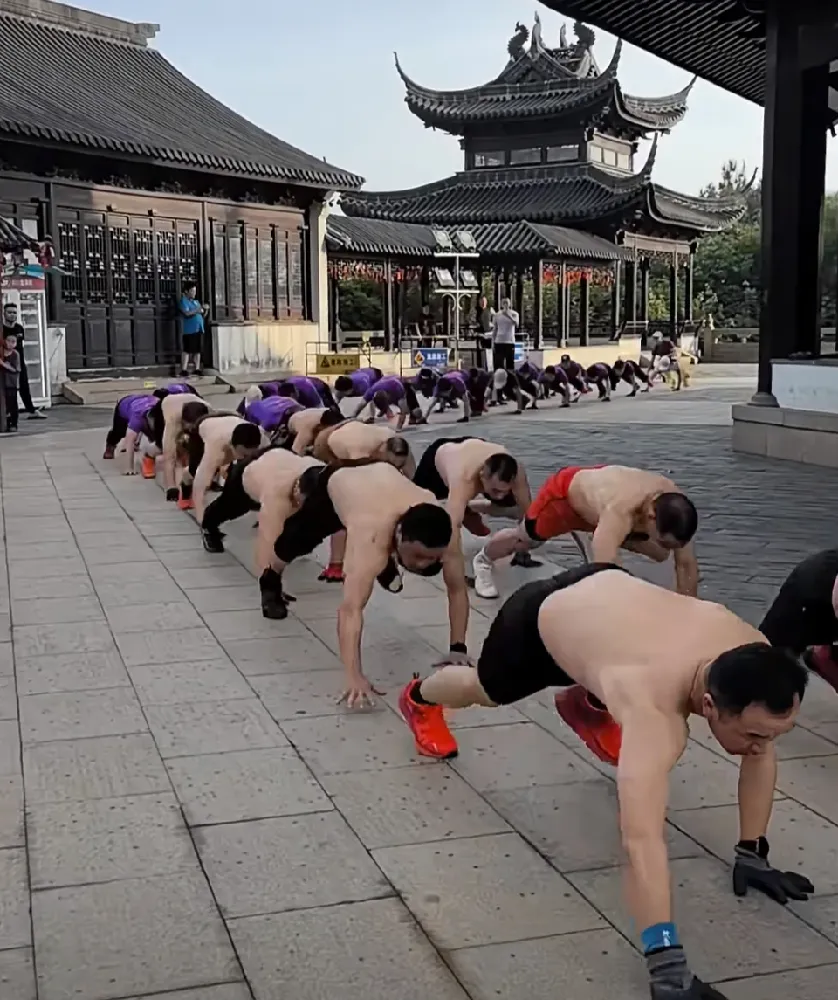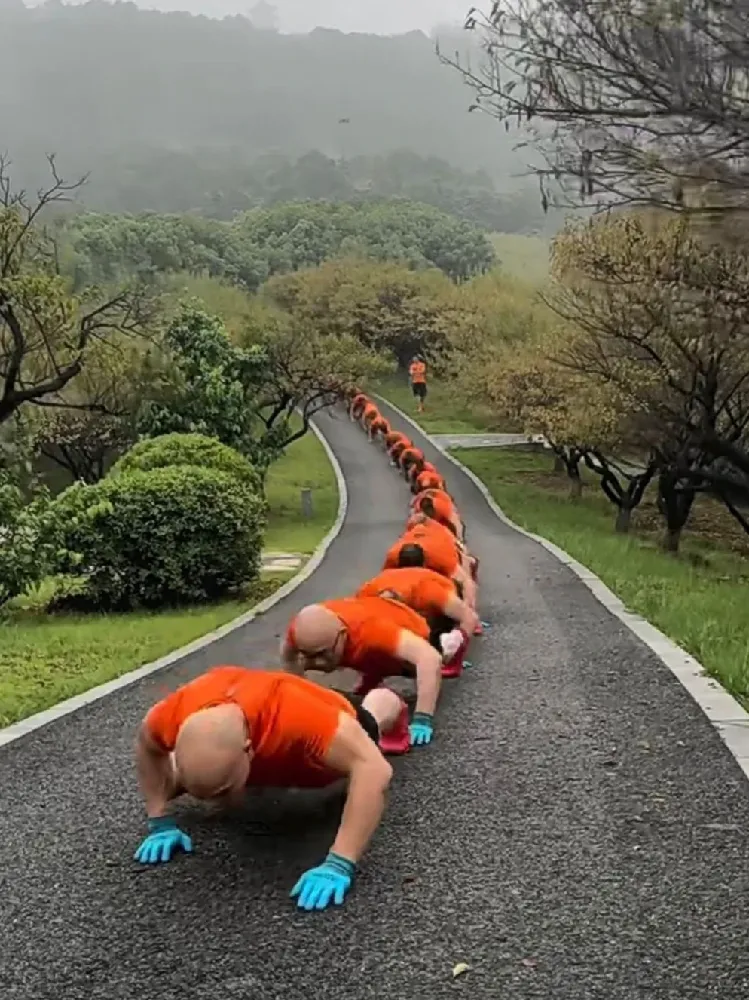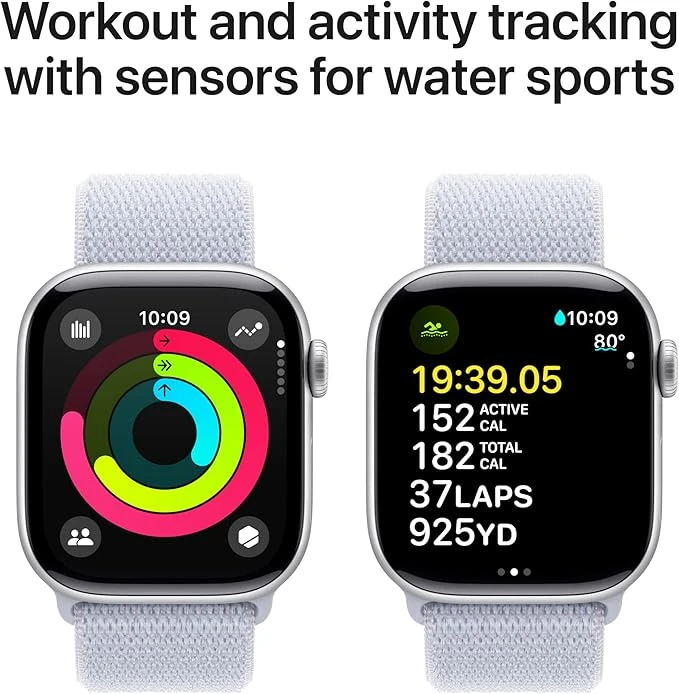In the ever-evolving landscape of fitness trends, where new workouts emerge almost weekly, one particularly intriguing movement has been making waves across social media platforms and gym floors alike.
Welcome to the world of Crocodile Crawl – a bodyweight exercise that's part of the broader quadrobics movement that's taking the fitness world by storm.

What Exactly is the Crocodile Crawl?
The hashtag #CrocodileCrawl refers to a bodyweight exercise that builds core, pushing, and shoulder strength through a crawling motion.
It's a form of animal movement and functional strength training that is popular in calisthenics and sports like wrestling due to its ability to improve overall conditioning and body control.
At its essence, the Crocodile Crawl is a functional fitness exercise where you mimic the movement of a crocodile crawling, which involves a low, ground-based motion.
Unlike its cousin, the Bear Crawl, the Crocodile Crawl maintains the body closer to the ground, creating unique challenges and benefits that we'll explore in depth.
The Science Behind Quadrobics: More Than Just a Social Media Trend
"Quadrobics" is the internet's latest fitness trend. This unconventional training method involves using all four of your limbs during a workout.
Proponents claim it's a highly beneficial form of exercise because of the large number of muscle groups that it uses.
By running on all fours, muscles in the shoulders, upper and lower arms, as well as the legs, back and core are used.
But is there scientific backing to these claims? Although there's limited research specifically on quadrobics, research does show that the greater the amount of muscle used in a workout, the more benefits your cardiovascular fitness and health will see.
Consider this comparison: research which has compared cycling and running has shown that running leads to greater cardiorespiratory fitness gains than cycling does. This is probably due to the different amounts of muscles each activity uses.
Cycling focuses mainly on the legs and lower body, while running is more of a whole-body exercise. Since running places demand on a greater number of muscles, this may explain why it leads to greater fitness gains.
Quadrobics, which apparently uses almost all of the major muscle groups, should therefore lead to greater gains than either running or cycling. However, the research presents some interesting contradictions.
When one study compared quadrobics to a standard walking programme, quadrobics oddly did not seem to use more energy – despite spiking heart rate to a greater degree.
This finding probably comes down to the fact that both activities use the same muscle groups, but just to varying degrees.

Comprehensive Benefits of Crocodile Crawl and Quadrobics
The benefits of incorporating Crocodile Crawl into your fitness routine extend far beyond what meets the eye:
Builds Comprehensive Strength
The Crocodile Crawl specifically targets core, pushing, and shoulder strength in ways that traditional exercises often miss. The low-to-ground position creates constant tension throughout the entire anterior chain, from shoulders to hips.
Enhances Body Awareness and Control
One of the most underrated benefits is the development of body control and awareness, which can improve performance on machines as well, according to various fitness experts. This heightened kinesthetic awareness translates to better performance in virtually every other physical activity.
Improves Overall Conditioning
The cardiovascular demands of sustained crawling help build overall physical conditioning in a way that's joint-friendly and sustainable.
Promotes Creative Movement
In an era where many find going to the gym can become uninspiring and boring over time, quadrobics could offer a solution to this. The Crocodile Crawl offers an alternative to traditional gym equipment and can be a fun way to train, bringing an element of play back into fitness.
Potential Benefits for Flexibility and Balance
One study looked at the effect of an eight-week quadrobics training plan in young people. It found that compared to the control group (who did two 60-minute sessions of typical physical activity), the quadrobics group saw greater improvements in shoulder flexibility and balance.
The Turkish Family Case Study: A Scientific Perspective
The conversation about quadrupedal movement wouldn't be complete without addressing the fascinating case of the Ulas family from Turkey.
This family has a way of walking that almost no other person on Earth does naturally – some members walk on all fours, using the palms of their hands in what's called a "bear crawl."
Out of the 19 children born to the family, five of them display this unusual movement throughout their lives beginning in early infancy.
When initially observed by Üner Tan of Çukurova University Medical School, it was controversially claimed they were a result of "backwards evolution" – a diagnosis that British scientists later called "deeply insulting to this family."
Subsequent research revealed that the gait was a consequence of two rare conditions occurring at once: a congenital cerebellar ataxia (a recessive inherited condition affecting balance) combined with a unique developmental pattern where the children used a bear crawl instead of traditional crawling during infancy.
This case study, while extraordinary, highlights an important distinction: the difference between pathological quadrupedalism and the intentional, strength-building Crocodile Crawl practiced in fitness contexts.
Modern Quadrobics Culture: More Than Just Exercise
Scroll through TikTok or Instagram fitness content these days, and the quadrobics movement is unmistakable.
The movement combines elements of parkour, gymnastics, and animal locomotion, creating workouts that are part fitness routine, part creative expression, and part return to "primal movement."
There's an extra cultural element to the practice: The aesthetic component—complete with animal ears, tails, and masks—has become just as important as the physical exercise itself for many participants.
This fusion of fitness and identity expression represents a fascinating development in how people approach physical health in the digital age.
Practical Implementation: Getting Started with Crocodile Crawl
For those interested in trying the Crocodile Crawl, here's a structured approach:
Beginner Protocol
Start with short sessions of 2-3 minutes, focusing on maintaining proper form. The key elements include:
- Keeping the body low to the ground
- Moving opposite limbs simultaneously (right hand with left foot)
- Maintaining a neutral spine position
- Breathing rhythmically throughout the movement
Progressive Variations
As Instagram posts suggest, the Crocodile Crawl can be modified with different variations to make it more challenging, creative, and coordinated. These include:
- Lateral Crocodile Crawls
- Weighted Vest Crawls
- Incline and Decline Variations
- Combination movements with other animal flow exercises
Safety Considerations
The potential risk of wrist, elbow, or shoulder issues is significant, particularly for older adults or those with pre-existing conditions.
Proper warm-up, progressive loading, and attention to form are crucial for injury prevention.
Who Benefits Most from Crocodile Crawl Training?
Athletes
Especially those in wrestling or other grappling sports, who use crawling exercises for training. The functional strength and body control developed through Crocodile Crawls translate directly to mat performance.
Rehabilitation Patients
When properly supervised, the low-impact nature of crocodile crawling can benefit those recovering from certain types of injuries, particularly those that prevent upright exercise.
Fitness Enthusiasts Looking for Variety
Anyone looking to build functional strength and improve their body control with bodyweight exercises will find value in incorporating Crocodile Crawls into their routine.
People Bored with Traditional Exercise
The novelty of quadrobics may provide an entrance point to health and fitness – especially for those who may find conventional workouts boring.
The Bigger Picture: Where Does Crocodile Crawl Fit in Modern Fitness?
While quadrobics enthusiasts are having their moment in the social media spotlight, it's worth remembering that human beings evolved to be pretty solid at bipedal locomotion. Running, walking, jumping, dancing, cycling, swimming—the list of highly effective exercises you can do on two legs is virtually endless.
The most important thing isn't how many limbs an exercise uses—it's that you move your body regularly in ways that challenge it, bring you satisfaction, and support your long-term health.
The beauty of movements like the Crocodile Crawl is that they offer another tool in the fitness toolbox – one that many people find enjoyable and effective.
Conclusion: Embracing Evolutionary Movement in Modern Contexts
The Crocodile Crawl represents more than just another fitness trend; it's part of a broader movement toward embracing more natural, varied movement patterns in our increasingly sedentary world.
While the research on quadrobics specifically remains limited, the principles behind it – full-body engagement, functional strength development, and varied movement patterns – are well-supported by exercise science.
The real key is finding forms of movement that you genuinely enjoy and can sustain over time.
For some people, that might indeed involve channeling their inner crocodile. For others, it's a simple daily walk or traditional strength training.
The "best" workout is ultimately the one you'll actually do consistently.
As fitness continues to evolve in the digital age, the Crocodile Crawl and quadrobics movement demonstrate an exciting direction: one that values functional ability, creative expression, and getting back to our movement roots – even if that means getting down on all fours occasionally.
The Complete Guide to Crocodile Crawl and Quadrupedal Movement: From Beginner to Advanced
What's the difference between Crocodile Crawl and Bear Crawl?
Crocodile Crawl involves low-to-ground movement with continuous core engagement, mimicking a crocodile's stealthy motion, while Bear Crawl features slightly bent knees and higher hip position. Crocodile Crawl emphasizes core stability and scapular control, whereas Bear Crawl focuses more on limb coordination and hip flexibility.
What exactly is Quadrupedal Movement?
Quadrupedal Movement refers to training methods where humans imitate animal locomotion using all four limbs, including crawling, jumping, and rolling patterns. It's an essential component of functional training that activates primitive movement patterns gradually lost during human evolution.
How does Animal Flow relate to Crocodile Crawl?
Crocodile Crawl serves as one of the foundational movements in the Animal Flow training system. Animal Flow, created by Mike Fitch, is a ground-based movement practice that incorporates various quadrupedal forms and transitions.
Is Quadrobics the same as traditional crawling exercises?
While both involve four-limb movement, Quadrobics represents a more systematic approach that includes specific gait patterns, rhythmic variations, and often incorporates creative elements and costumes, making it distinct from basic crawling exercises.
What muscle groups does Crocodile Crawl primarily target?
Crocodile Crawl comprehensively engages the core stabilizers, shoulder girdle muscles (deltoids, rotator cuff), scapular stabilizers, hip flexors, and glutes. It also activates deep cervical flexors for neck stability and promotes integrated full-body coordination.
Can Crocodile Crawl help with back pain and spinal issues?
Yes, when performed correctly. The movement promotes spinal decompression and strengthens the entire core complex. Studies show controlled quadrupedal movement can improve intervertebral disc health and reduce pressure on lumbar structures by up to 40% compared to upright positions.
How does quadrupedal training benefit cardiovascular health?
Research indicates that quadrupedal movement elevates heart rate significantly while maintaining lower impact on joints. A 2023 study showed regular practitioners experienced 12-15% improvement in VO2 max and better heart rate variability metrics.
Does this training improve brain function and coordination?
Absolutely. The cross-lateral movement pattern stimulates communication between brain hemispheres, enhancing neural connectivity. Regular practice has shown to improve proprioception, spatial awareness, and complex motor planning abilities.
What's the proper form for beginner Crocodile Crawl?
Start in a plank position, lower hips slightly, maintain neutral spine. Move opposite hand and foot simultaneously, keeping elbows soft and movements fluid. Head should follow natural spinal alignment, gaze slightly forward.
How to program Crocodile Crawl into my workout routine?
Begin with 2-3 sets of 20-30 second intervals, 2-3 times weekly. Progress to 45-60 second intervals as endurance improves. For strength focus, add weight vests; for metabolic conditioning, incorporate into circuit training.
What are the key progression variations?
Level 1: Basic Crocodile Crawl → Level 2: Lateral Variations → Level 3: Loaded Crawls (weight vest) → Level 4: Combination flows with other animal movements → Level 5: Speed and endurance challenges.
How to combine with other training modalities?
Excellent combinations include: with yoga for mobility, with calisthenics for strength integration, with running for cross-training, and with martial arts for practical application of movement skills.
What are the most common mistakes to avoid?
Key errors include: elevated hips (turning into bear crawl), holding breath, looking straight down causing neck strain, locked elbows, and moving same-side limbs simultaneously instead of diagonal patterns.
How to protect wrists and shoulders during extended sessions?
Implement wrist mobility exercises beforehand, use push-up handles for wrist neutrality, engage scapular stabilizers throughout movement, and gradually increase duration to allow connective tissue adaptation.
Who should avoid or modify Crocodile Crawl training?
Contraindications include: acute wrist/shoulder injuries, certain pregnancy stages, severe carpal tunnel syndrome, and recent abdominal surgery. Always consult healthcare providers for specific medical conditions.
Is Crocodile Crawl suitable for office workers?
Highly beneficial. Counteracts prolonged sitting effects, improves posture, and can be done in short breaks. Mini-sessions of 3-5 minutes significantly reduce lower back discomfort from sedentary work.
Can seniors safely practice quadrupedal movement?
With proper modifications: use padded surfaces, shorter durations, and potentially elevated surfaces (table position). Improves balance, bone density, and functional strength crucial for aging populations.
How do athletes benefit from specialized crocodile variations?
Combat sports athletes develop ground mobility, football players enhance change-of-direction ability, gymnasts improve body awareness, and endurance athletes build auxiliary stabilizer endurance.
What does recent research say about evolutionary aspects?
Current studies suggest reintroducing quadrupedal patterns may address "movement malnutrition" in modern humans. Research from evolutionary biology departments indicates it activates dormant neuromuscular pathways.
How does this training impact long-term mobility preservation?
Longitudinal observations show practitioners maintain better shoulder health, spinal flexibility, and movement variability into advanced age compared to single-plane exercise specialists.
How to measure progress beyond time and distance?
Track movement quality metrics: smoothness of transitions, consistency of hip height, breathing pattern stability, and reduction of compensatory movements over training cycles.


